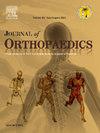Measurement of Periarticular Subcutaneous Fat on CT Images and Adverse Outcomes Following Total Knee Arthroplasty
IF 1.5
Q3 ORTHOPEDICS
引用次数: 0
Abstract
Background
Obesity is associated with a higher rate of wound complications following primary total knee arthroplasty (TKA). With readily available computer tomography (CT) images from robotic-assisted TKA, we analyzed measurement of fat content on preoperative CT images as a possible predictor of wound complications following primary TKA.
Methods
Patients who underwent robotic-assisted TKA at one institution in 2018 were included in this retrospective cohort study. Two independent reviewers measured three SCF areas at different axial CT cuts and normalized them by dividing the area of the distal femur. These areas were distributed into 4 groups. Any wound complication that required clinical or surgical intervention was reviewed and analyzed. For further comparison, prepatellar SCF thickness ratio measured on CT scan and BMI were grouped and analyzed similarly for wound complications. We also analyzed any association of SCF measurement with secondary outcomes such as operative time, length of stay, readmission, and reoperation.
Results
One hundred fifty patients with diagnosis of osteoarthritis, mean age of 64 years and BMI of 34.3 kg/m2 were included in this study. Ninety-one patients (61%) were female. Normalized SCF measurements at 2 cm above the patella, mid-patella, and tibial tubercle had excellent intraclass correlation coefficient at 0.987, 0.989, and 0.989, respectively. When SCF at 2 cm above patella was analyzed, Group 1 (smallest amount of SCF) had a significantly higher wound complication rate compared with Groups 2 and 3 combined (18.9 vs 5.3%, p=0.036). Group 4 (largest amount of SCF) also had a significantly higher wound complication rate compared with Groups 2 and 3 combined (18.9 vs 5.3%, p=0.036).
Conclusions
Accurate and consistent measurement of periarticular fat around the knee based on axial CT images demonstrated that moderate amount of fat is associated with better clinical outcomes following primary TKA. Our study did not find any clinical significance of gender difference in fat distribution. Therefore, more studies should be undertaken to evaluate for any clinical association of gender-specific fat distribution and to confirm our finding that a certain amount of fatty tissue is necessary for improved outcomes following TKA.
CT 图像上关节周围皮下脂肪的测量与全膝关节置换术后的不良后果
背景肥胖与初级全膝关节置换术(TKA)后较高的伤口并发症发生率有关。利用现成的机器人辅助 TKA 计算机断层扫描(CT)图像,我们分析了术前 CT 图像上脂肪含量的测量值,将其作为原发性 TKA 术后伤口并发症的可能预测因子。方法2018 年在一家机构接受机器人辅助 TKA 的患者被纳入这项回顾性队列研究。两名独立审查员在不同的轴向 CT 切面上测量了三个 SCF 区域,并通过划分股骨远端面积对其进行归一化处理。这些区域被分为 4 组。对任何需要临床或手术干预的伤口并发症进行审查和分析。为了进一步比较,我们将 CT 扫描测量的髌前 SCF 厚度比和体重指数进行了分组,并对伤口并发症进行了类似的分析。我们还分析了 SCF 测量与手术时间、住院时间、再次入院和再次手术等次要结果之间的关联。91名患者(61%)为女性。髌骨上方 2 厘米、髌骨中部和胫骨结节处的归一化 SCF 测量值分别为 0.987、0.989 和 0.989,具有极佳的类内相关系数。在分析髌骨上方 2 厘米处的 SCF 时,第 1 组(SCF 量最少)的伤口并发症发生率明显高于第 2 组和第 3 组(18.9% vs 5.3%,P=0.036)。结论根据轴向 CT 图像对膝关节周围脂肪进行精确一致的测量表明,适量的脂肪与初次 TKA 后较好的临床预后相关。我们的研究并未发现脂肪分布的性别差异有任何临床意义。因此,应开展更多的研究来评估不同性别的脂肪分布是否与临床相关,并证实我们的发现,即一定量的脂肪组织是改善 TKA 后疗效的必要条件。
本文章由计算机程序翻译,如有差异,请以英文原文为准。
求助全文
约1分钟内获得全文
求助全文
来源期刊

Journal of orthopaedics
ORTHOPEDICS-
CiteScore
3.50
自引率
6.70%
发文量
202
审稿时长
56 days
期刊介绍:
Journal of Orthopaedics aims to be a leading journal in orthopaedics and contribute towards the improvement of quality of orthopedic health care. The journal publishes original research work and review articles related to different aspects of orthopaedics including Arthroplasty, Arthroscopy, Sports Medicine, Trauma, Spine and Spinal deformities, Pediatric orthopaedics, limb reconstruction procedures, hand surgery, and orthopaedic oncology. It also publishes articles on continuing education, health-related information, case reports and letters to the editor. It is requested to note that the journal has an international readership and all submissions should be aimed at specifying something about the setting in which the work was conducted. Authors must also provide any specific reasons for the research and also provide an elaborate description of the results.
 求助内容:
求助内容: 应助结果提醒方式:
应助结果提醒方式:


